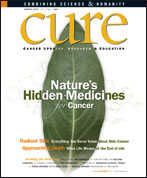Publication
Article
CURE
Nature's Spoils
Author(s):
Treading lightly with discoveries.
Nearly a quarter of all medicines in the United States can be traced back to rain forests, and an abundance of undiscovered medicinal products await discovery in Earth’s oceans. With the increased interest in natural products that may have a commercial use—known as bioprospecting—and improved laboratory methods, ownership of these products and the profit made from them has become a controversial subject.
With the discovery of natural product-based blockbuster drugs—many from underdeveloped countries—comes concerns about exploitation of these natural products. In the past, if drugs created from natural products were effective, the company or institution responsible for isolating and creating the usable product received the profits from marketing the drug; the product’s country of origin was usually not compensated. Environmentalists also voiced worries about the destruction of natural resources because the active compound was usually found in very small amounts, so more product was needed.
The Biodiversity Treaty, proposed by the United Nations in 1992, attempted to address bioprospecting concerns. The treaty included giving national governments exclusive control over natural products found within their borders, but not intellectual property rights, such as genetic information. While close to 200 countries ratified the treaty, the United States not among them, some countries are now passing their own laws to regulate genetic information of their natural resources. But that may still not be enough. In 2005, a Japanese-based United Nations organization issued a report detailing the lack of regulations in deep sea bioprospecting—a potential problem on both sides of the coin. While unregulated bioprospecting could damage the ocean’s ecosystem, unclear rules could also deter important research by private companies.
Since the Biodiversity Treaty was first presented, collecting methods have become more sophisticated and now only small amounts of product are usually needed for research. Bioprospecting has also changed to accommodate local governments. “What’s important is that we work very closely with the host countries to get permission,” says David Sherman, PhD. “They know exactly what we’re doing, where we’re going and how many samples we’re collecting.”
There have been drawbacks to the treaty, though. With the inability of researchers to collect and sample certain natural products, scientists worry that useful medicines will go undiscovered, especially with the destruction of rain forests and coral reefs caused by global warming and deforestation, among other causes. “We’re losing a tremendous amount of natural environment each year,” says Bruce Chabner, MD, a professor of medicine at Harvard Medical School, who was involved in the clinical testing of Yondelis. “If we don’t collect them now, we’ll miss the opportunity to find things that have medicinal value.”
Even before the treaty, a private collaboration between a country rich in undiscovered organisms and a private drug company was formed. In 1991, Merck partnered with Costa Rica’s Instituto Nacional de Biodiversidad (INBio) to collect plants and other organisms on the island in exchange for a lump sum and a share of the royalties if a useful drug is created from Costa Rica’s resources.
Once bioprospectors get beyond the collection debate, controversy carries over to the issue of who can patent nature’s medicines—and if they should be patented at all. In 1980, the U.S. Supreme Court narrowly ruled that human-made bacteria could be patented after a microbiologist created an organism that could clean up oil spills by inserting new genes into an existing bacterium to degrade crude oil. Since that ruling, emerging biotechnology advances have made discovering, isolating and manipulating nature’s own ingredients easier and, therefore, more numerous. For each worthwhile discovery, a patent is needed to protect the discovery from reproduction before the product is produced and marketed.
An invention or discovery deemed patentable must be new, unobvious (involve an inventive step) and have some industrial use. For example, if a person discovers a fungus with medicinal properties and isolates the active compound, that compound could be patented. If a scientist mutates that fungus to provide it with other properties, it can also be patented. While local communities may have been using a natural medicinal product for centuries, it cannot be patented until the active compound is isolated, typically by a commercial or educational institution.
Every new and unobvious way of producing or isolating a potential drug is deemed patentable, says patent attorney John Hogan. Most patents are effective for 20 years after the application date, after which a generic form of the product can be reproduced or the process copied.
With developing technology and discovery techniques, an increasing number of organisms will be found and marketed in the coming years. Experts estimate more than 300 potential new drugs await discovery in the rain forests and even more from marine organisms.






